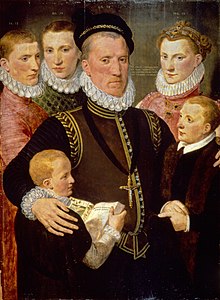|
Robert Seton, 1st Earl of Winton
Robert Seton, 1st Earl of Winton (1553 – 22 March 1603) was one of the Scottish peers who supported Mary, Queen of Scots. Early years The son of George Seton, 7th Lord Seton, Robert Seton grew up active in the affairs of his father and of the State. He was educated early in France, and accompanied his father during his ambassadorships to France during the reign of Queen Mary. As a youth, he grew up a close childhood friend of the Queen's son, the future King James VI. LangsideLike his father, he was strongly attached to the Queen and to the Royal House of Stuart, and was part of his father's rescue party for Queen Mary from Lochleven Castle. He was also present at the battle of Langside in 1568. He was later one of the party who rescued King James VI from the hands of the Douglases, and supported his monarch during the Gowrie and other conspiracies of the time. EstatesUpon the death of his father, in 1586, Robert succeeded as 8th Lord Seton. Although his father left the estates heavily encumbered by reason of the great expense of several embassies and of his losses suffered by adhering to the Queen's party, yet by prudence and ability he was soon able to put his affairs in good condition and provide both sons and daughters with respectable fortunes. He was very hospitable at Seton Palace, where the king and queen, and ambassadors and strangers of quality were nobly entertained."[2] In August 1594 he was Grand Master of the King's Household at the baptism of Prince Henry at Stirling Castle. This state role was usually held by the Earl of Argyll, but he was out of favour.[3] Balthasar Fuchs von Bimbach came to the baptism with the Danish ambassadors and kept an Album Amicorum, a kind of autograph book, recording the people he met, including Seton. Seton drew a sketch of his heraldry and monogram in the book, with his motto "Indissolubile", meaning "inseperable".[4] When James VI planned to visit the west and the islands of Scotland in August 1598, Lord Seton was made convenor of the Privy Council.[5] He improved his property, especially by working on the old harbour of Cockenzie, a fishing village of great antiquity on the Firth of Forth, to accommodate vessels of a larger size. In January 1599 the king granted him a charter under the Great Seal of Scotland concerning Cockenzie, which had previously been erected into a free port and burgh of barony. He was a great favorite of James VI, and was created Earl of Winton at Holyroodhouse on 16 November 1600.[6] ReligionA strict Roman Catholic, the Earl and his family suffered indignities from the Presbytery of Haddington, East Lothian, as may be seen by the Records. One entry reads thus: "1597. Setoun Kirk. The Presbitery asked Lord Setoun if he will suffer them to sit in the Kirk of Setoun for the space of two or three days, because they are to 'gang about' all the churches within their bounds; but this his Lordship altogether refused." Protestant worship has never been held in Seton Church, as after the family conformed they attended the Tranent parish church, leaving their own church deserted, as it has remained ever since. Marriage and childrenIn 1582, Lord Seton married Lady Margaret Montgomerie, eldest daughter of Hugh Montgomerie, 3rd Earl of Eglinton, by whom he had five sons and a daughter:[7]
Death and burialIn his Latter-Will, dated 28 February 1603, the Earl wrote, "My body to be buried whole in most humble, quiet, modest, and Christian manner without all extraordinary pomp or unlawful ceremony, within my College Church of Seton among my progenitors of worthy memory." By the words unlawful ceremony, the staunch old Catholic nobleman may have meant that he didn't want any Protestant interference or Kirk rites at his funeral. He was buried on Tuesday 5 April, on the same day that King James VI of Scotland set out from Edinburgh for London to become King James I of England.[9] The king's company waited at the orchard of Seton Palace until the funeral was over, so that mourners did not leave to follow the king.[10] The 19th-century historian Patrick Fraser Tytler imagined the scene:
References
|
||||||||||||||||||||||||
